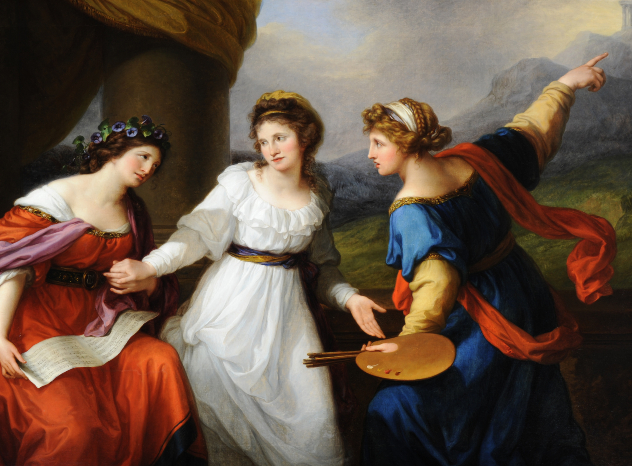The Holy Family with the Infant Saint John in a Landscape
circle of Raphael (Urbino 1483 – Rome 1520)
Category
Art / Oil paintings
Date
1516 - 1517
Materials
Oil on panel
Measurements
760 x 533 mm (30 x 21 in)
Place of origin
Siena
Order this imageCollection
Kingston Lacy Estate, Dorset
NT 1257083
Caption
Painted by an Italian, looted from a Spanish castle and bought from a Frenchman - who threw in a donkey - by an eccentric travelling Englishman. The story behind this painting of the Holy Family speaks of the mobility of art and elite wealth in war-ravaged Europe in the early 19th century. The Englishman in question was the adventurer and collector, William Bankes, who served as the aide-de-camp to the Duke of Wellington during the Peninsular War. ‘Gentlemen’, the Iron Duke is purported to have said, ‘There will be no looting in this campaign and that includes you, Bankes’. In the case of the Holy Family, the French had already carried out the looting. Bankes encountered this picture, believed to have been painted by Raphael, in the autumn of 1813, when Bankes was living ‘in disguise’ behind the French lines in the besieged city of Pamplona. In a story he would recount years later, it was there that he dined with the French commanding officer, ‘who regaled him with a meal of rats, washed down with strong drink, and after dinner obliged him to buy a Raphael, which he had stolen from the Sacristy of the Escorial, and a donkey, which I don’t think he had stolen from anybody’. The painting, which has since been attributed to the circle of Raphael, had belonged successively to Vincenzo II Gonzaga, King Charles I and Philip IV of Spain. Aware of this illustrious provenance and convinced of Raphael’s authorship, Bankes commissioned an ornately carved frame of the highest quality from Pietro Giusti of Siena, the most famous Italian wood-carver of the period. As for the donkey, Bankes is said to have become so fond of the creature that he sent him back to England, despite the captain of the ship declaring that ‘the jackass should pay like a gentleman.’
Summary
Oil painting on panel, The Holy Family with the Infant Saint John in a Landscape, circle of Raphael (Urbino 1483 – Rome 1520), possibly Gianfrancesco Penni (Florence 1488/1496 – Naples 1528), 1516/17. The walnut frame, commissioned by William Bankes in 1853, is by Pietro Giusti (Siena 1822 - Turin 1878) and bears the date 1856.
Provenance
Vincenzo Gonzaga I, 4th Duke of Mantua (1562 - 1612); King Charles I, in 1626-28; acquired for Philip IV of Spain during the Commonwealth, it was looted by the French from the sacristy of the Escorial in the Peninsular War; bought as a Raphael in Spain in 1813 by William John Bankes (1786 - 1855) who commissioned the frame from Pietro Giusti (Siena 1822 - Turin 1878) in Siena in 1853; and thence by descent until bequeathed by (Henry John) Ralph Bankes (1902 – 1981) to the National Trust, together with the estates of Corfe Castle and Kingston Lacy and its entire contents in 1981
Marks and inscriptions
Verso: On the back of the panel are the brands of two of its certain previous owners: 1) Vincenzo I Gonzaga, 4th Duke of Mantua (1562-1612) (cipher stamped on panel) 2) King Charles I - crown and cypher: CR (crown and cipher stamped on panel)
Makers and roles
circle of Raphael (Urbino 1483 – Rome 1520), artist Gianfrancesco Penni (Florence 1488/1496 – Naples 1528), artist Pietro Giusti (Siena 1822 - Turin 1878), framemaker previously catalogued as attributed to Giulio Romano (Rome c.1499 - Mantua 1546), artist
Exhibition history
Late Raphael, Museo Nacional del Prado, Madrid, 2012 - 2013, no.60 Late Raphael, Musée du Louvre, Paris, 2012 - 2013, no.60
References
(Late Raphael) El último Rafael, Museo del Prado, Madrid, 12 June - 16 September 2012 and Raphael, les dernières anneés, Musée du Louvre, 18 October - 14 January 2013, 60 Rowell 2014, Christopher Rowell, 'The Kingston Lacy 'Raphael' and its Frame (1853-56) by Pietro Giusti of Siena in National Trust Historic Houses & Collections Annual (Apollo), 2014, pp.40 - 47 Shawe-Taylor 2018: Desmond Shawe-Taylor and Per Rumberg (eds.), Charles I: King and Collector, (exh. cat.), Royal Academy of Arts, London: 2018, 49


